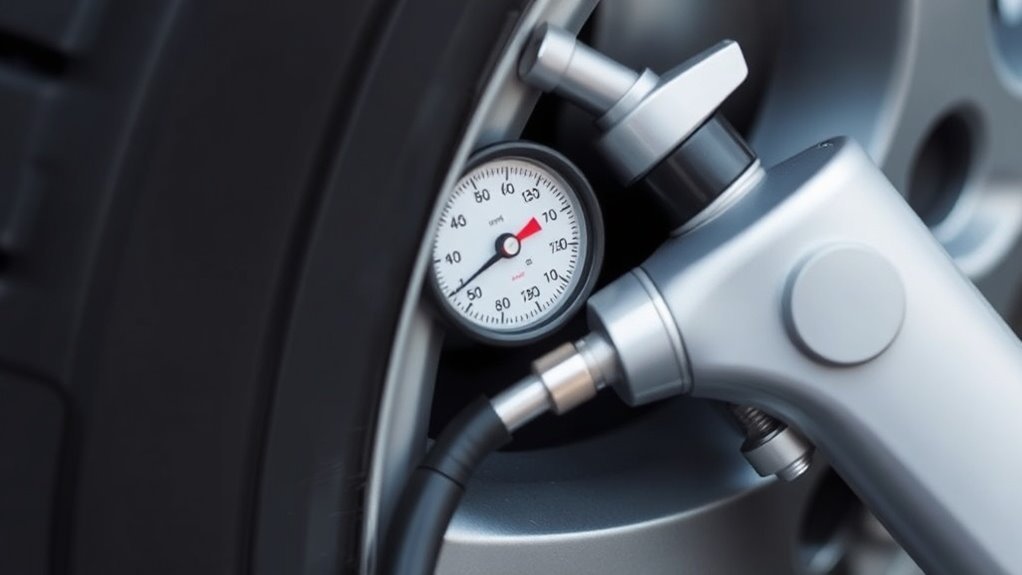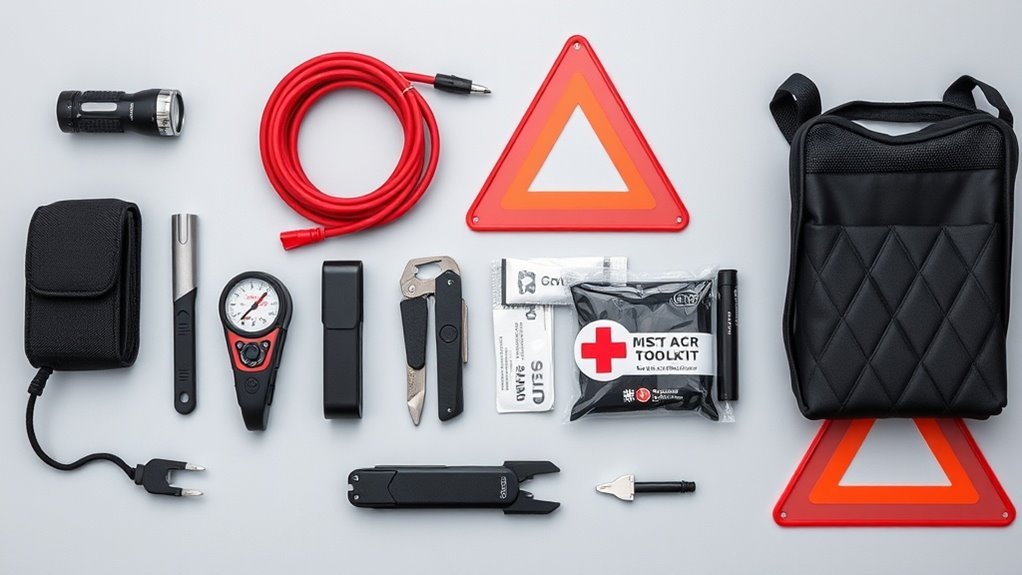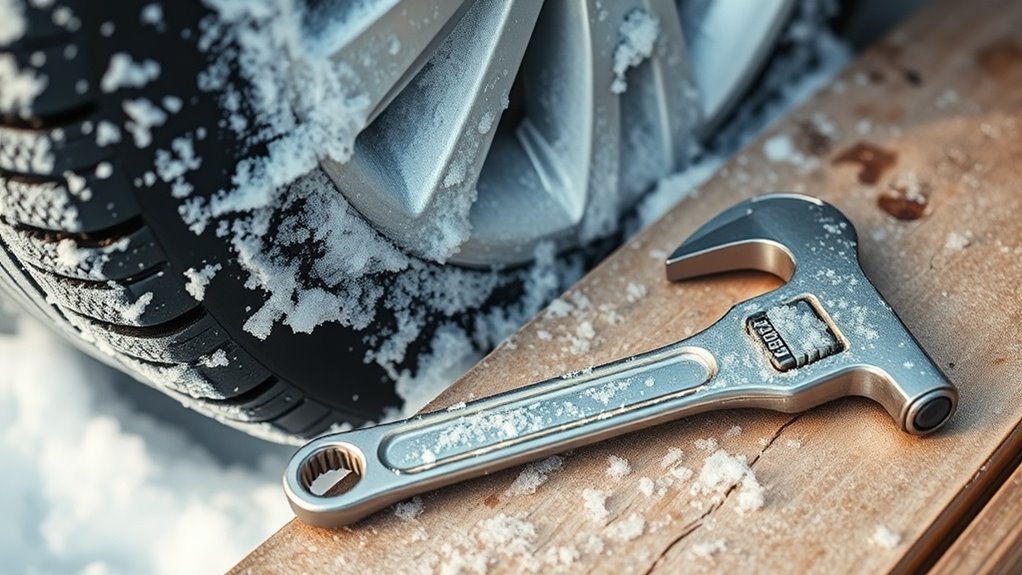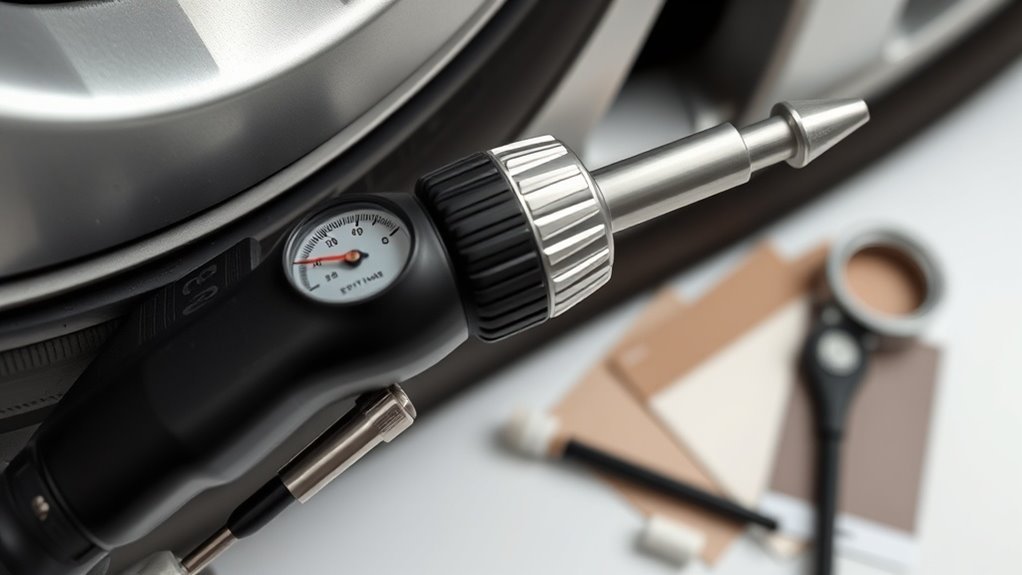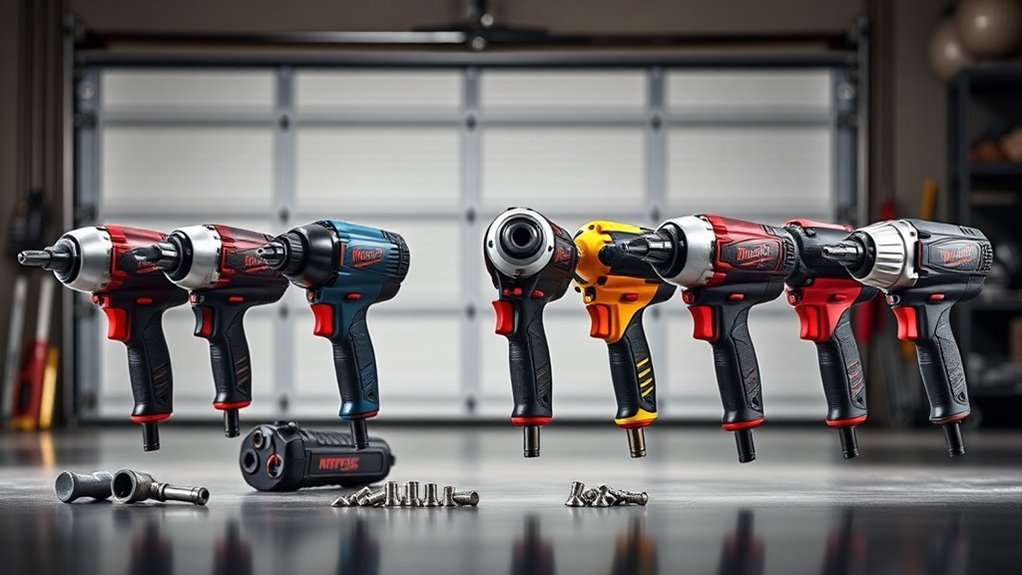The Science of Portable Jump Starters and Battery Safety
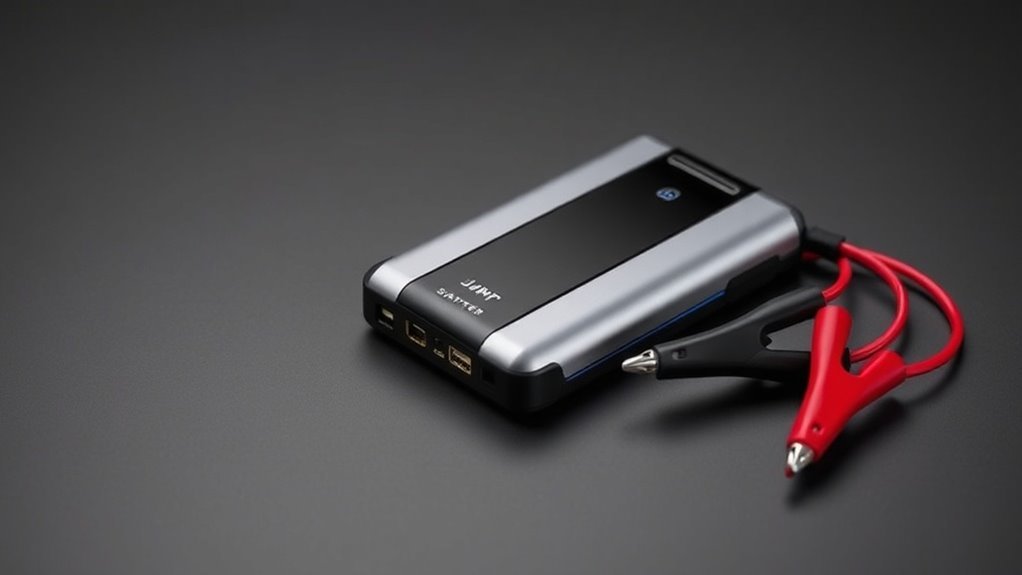
Portable jump starters use batteries, often lithium-ion, to deliver a high surge of power to revive dead car batteries safely. They include safety features like reverse polarity alerts and overload protection to prevent errors and hazards. Properly using a jump starter means connecting the clamps correctly and ensuring both vehicles are off. Regular maintenance, like charging every few months and checking cables, will extend your jump starter’s life. There’s more to learn about ensuring battery safety effectively.
Key Takeaways
- Portable jump starters use internal batteries to deliver a high voltage surge, enabling quick ignition of vehicles with dead batteries.
- Key safety features include reverse polarity alerts, overload protection, and spark-proof technology to prevent accidents during operation.
- Proper usage involves correct cable connections and careful disconnection to prevent sparks and ensure safety when jump-starting a vehicle.
- Regular maintenance, such as charging every 1-3 months and inspecting cables, enhances the reliability and longevity of portable jump starters.
- Compared to traditional jumper cables, portable jump starters offer convenience and ease of use, allowing individuals to jump-start vehicles without needing another car.
Understanding How Portable Jump Starters Work
Although you might think of them as just a backup power source, portable jump starters are actually sophisticated devices designed to revive dead batteries efficiently.
When you connect a jump starter to your vehicle’s battery, it delivers a surge of electrical energy, providing the necessary power for ignition. The process starts with the internal lithium-ion or lead-acid battery emitting a high voltage. This jump starts your car by getting the starter motor to crank up.
It’s essential to recognize that these devices have built-in safety features to prevent overloading or short circuits. By following the manufacturer’s instructions, you can guarantee a smooth jump-starting experience, minimizing risks and maximizing your vehicle’s recovery potential when you need it most.
The Components of a Portable Jump Starter
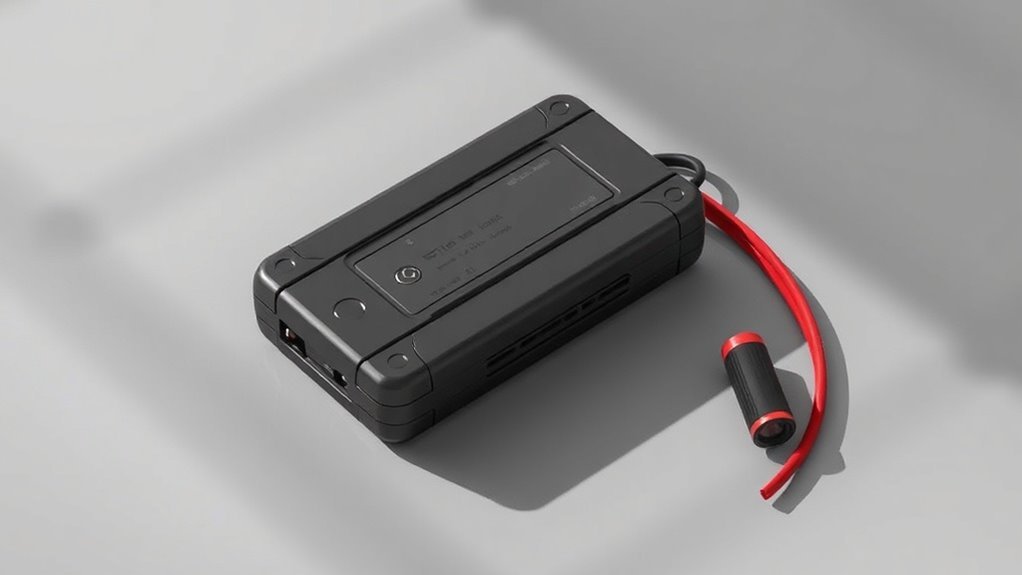
When you’re looking at portable jump starters, it’s important to know what’s inside.
Key components play a vital role in their effectiveness, along with essential safety features that keep you protected.
Let’s break down these elements so you can understand how they work together.
Key Components Explained
A portable jump starter is made up of several key components that work together to quickly revive a dead battery. The most essential part is the battery itself, often lithium-ion, which stores energy until needed.
You’ll also find jumper cables, typically with clamps that connect to your vehicle’s battery terminals. The built-in inverter converts DC to AC power, allowing you to use other devices.
Charging ports, like USB outlets, let you power your gadgets, making these devices multifunctional. Also, many jump starters include a digital display to monitor battery voltage and remaining charge.
Together, these components provide a compact solution for dead batteries and emergency situations, ensuring you’re prepared for unexpected mishaps on the road.
Safety Features Overview
Portable jump starters are not just about reviving dead batteries; they also come equipped with several safety features to protect both you and your vehicle. These features help prevent mishaps during the jump-starting process, ensuring a smoother experience. Here’s a quick overview of key safety components:
| Safety Feature | Description |
|---|---|
| Reverse Polarity | Prevents damage by alerting when cables are reversed. |
| Overload Protection | Shuts off the unit if it detects excessive current. |
| Short Circuit Protection | Stops operation if a short circuit occurs. |
| Overheat Protection | Automatically turns off to prevent overheating. |
| Spark Proof Technology | Eliminates sparks during connection for added safety. |
With these features, you can jump-start your vehicle with confidence.
Types of Portable Jump Starters: Which One Is Right for You?
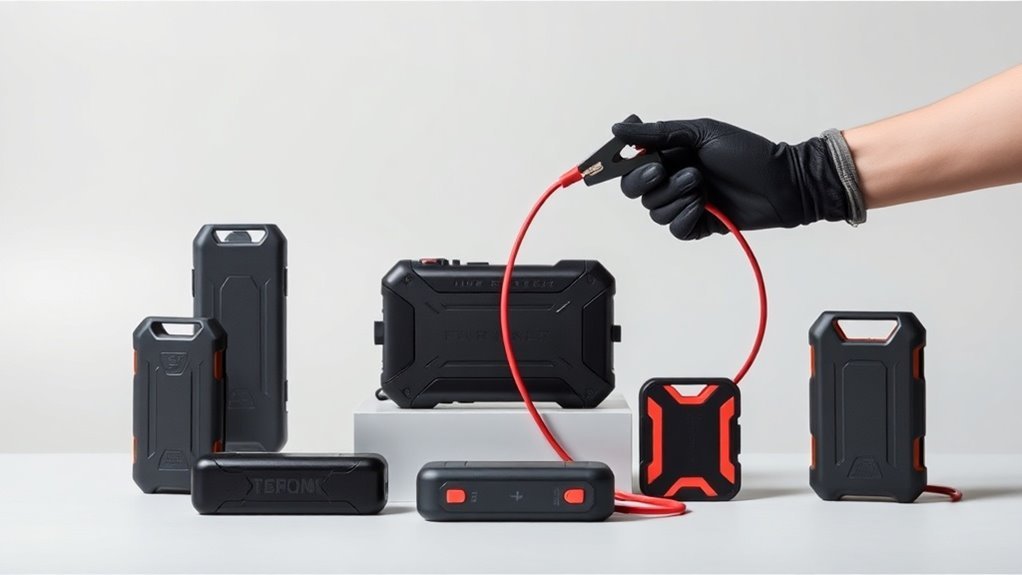
How do you choose the right type of jump starter for your needs?
First, consider your vehicle size. For small cars, a compact model with around 400-600 amps is sufficient. If you drive a larger vehicle or a truck, look for a heavy-duty jump starter with a higher amp rating, typically above 1000 amps.
Consider your vehicle size: for small cars, opt for 400-600 amps; larger vehicles need 1000 amps or more.
Next, think about additional features. Some jump starters come equipped with built-in air compressors, flashlights, or USB ports for charging devices, which can be helpful.
Also, check for weight and portability—smaller models are easier to store and carry.
Finally, read reviews to understand reliability and performance. Choosing the right jump starter guarantees you won’t be left stranded in case of an unexpected battery failure.
How to Properly Use a Portable Jump Starter
Before using your portable jump starter, it’s essential to perform some safety checks to guarantee everything’s in good condition.
Once you’re set, we’ll go over the right way to connect and disconnect the cables to avoid any accidents.
Let’s get started!
Pre-Usage Safety Checks
Assuring safety is essential when using a portable jump starter. First, check the jump starter’s charge level; it should have sufficient power to do the job.
Look for any signs of damage, like cracks or dents, which could lead to malfunction. Inspect the jumper cables for fraying or corrosion—if you spot any issues, it’s best not to use the device.
Make certain you’re in a well-ventilated area to prevent harmful fumes from building up. Keep the jump starter away from flammable materials, and remember to read the manufacturer’s instructions thoroughly to understand specific safety guidelines.
Following these pre-usage checks will help prevent accidents and assure that your jump starter functions smoothly when you need it most.
Connecting and Disconnecting Steps
Having completed your pre-usage safety checks, it’s time to connect your portable jump starter.
Start by making sure both the jump starter and the vehicle are powered off. Connect the red clamp to the positive terminal of the dead battery, followed by the black clamp to the negative terminal. If your jump starter has a ground connection, attach it to an unpainted metal surface on the engine block.
Once everything’s secure, turn on the jump starter.
After starting the vehicle, first disconnect the black clamp, then the red clamp. Store the jump starter safely.
Always be cautious and avoid touching the clamps together during the process; this prevents short circuits. Following these steps guarantees safety and effectiveness.
Signs Your Car Battery Needs a Jump Starter
When your car struggles to start, it’s often a sign that your battery might need a boost from a jump starter. Here are some telltale signs to watch for:
- Dimming headlights: If your headlights flicker or dim when you turn the ignition, it could indicate battery issues.
- Clicking sound: A rapid clicking noise when you try to start the engine means the battery isn’t supplying enough power.
- Electrical issues: If your dashboard lights and accessories fail to operate correctly, your battery might be weak or dying.
If you notice any of these signs, it’d be wise to grab your jump starter.
Don’t wait too long, as a weak battery can leave you stranded when you least expect it.
Safety Precautions When Using a Jump Starter
When using a jump starter, it’s essential to read the manufacturer’s instructions carefully.
You’ll also need to understand the proper connection sequence to avoid any mishaps.
Plus, keeping an eye on overcharging risks will help guarantee your safety and the longevity of your jump starter.
Read Manufacturer’s Instructions
Before you start using a jump starter, it’s essential that you read the manufacturer’s instructions carefully. These guidelines provide vital information that can help guarantee your safety and protect your device.
Ignoring this step could lead to accidents or damage.
Keep these key points in mind:
- Battery Compatibility: Make sure you check if your jump starter is compatible with your vehicle’s battery type to avoid any issues.
- Charging Instructions: Follow the recommended charging procedures to maintain battery life and performance.
- Safety Features: Familiarize yourself with the safety features, such as short-circuit protection, to minimize risks during operation.
Proper Connection Sequence
Establishing a proper connection sequence is essential for safely using a jump starter. Follow these steps to guarantee a secure connection and avoid damage:
| Step | Action |
|---|---|
| 1 | Turn off both vehicles. |
| 2 | Connect the red clamp to the positive terminal of the dead battery. |
| 3 | Connect the other red clamp to the positive terminal of the jump starter. |
| 4 | Connect the black clamp to the negative terminal of the jump starter. |
| 5 | Attach the other black clamp to a grounded metal surface on the working vehicle. |
Avoid Overcharging Risks
To prevent overcharging risks while using a jump starter, it’s important to monitor the charging process closely. Overcharging can damage the battery and reduce its lifespan.
To guarantee safe usage, keep these safety precautions in mind:
- Use a jump starter with built-in protection: Look for models that automatically shut off when charging is complete.
- Check the battery’s temperature: If it feels excessively hot, disconnect it immediately to prevent overheating.
- Limit charge time: Avoid charging longer than recommended; most batteries need just a few hours to reach full capacity.
Common Mistakes to Avoid With Jump Starters
While using a jump starter can be a lifesaver in a pinch, there are common mistakes that can lead to further complications or even damage your vehicle.
First, always connect the red clamp to the positive terminal first. Neglecting this step can cause a short circuit.
Next, don’t forget to attach the black clamp to a grounded metal part of your vehicle, not directly to the negative terminal, to avoid sparks.
Also, be careful not to crank the engine for too long—30 seconds is usually enough.
Finally, don’t ignore the jump starter’s instructions; they’re there for a reason. Following these simple guidelines will help prevent damage and guarantee a smooth start when you need it most.
Maintaining Your Portable Jump Starter for Longevity
Maintaining your portable jump starter properly is essential for guaranteeing it performs when you need it most.
Regular care can extend its lifespan and keep it reliable. Here are a few tips to help you maintain your device:
Regular maintenance enhances both the longevity and reliability of your portable jump starter.
- Charge Regularly: Keep your jump starter charged, ideally once every 1-3 months, to prevent battery depletion.
- Store Safely: Keep it in a cool, dry place. Extreme temperatures can damage the battery and reduce efficiency.
- Check Connections: Periodically inspect the cables and clamps for any signs of wear or damage to guarantee they function correctly.
How Portable Jump Starters Compare to Traditional Jumper Cables
When deciding between portable jump starters and traditional jumper cables, you’ll find that each option has its own set of advantages and drawbacks.
Portable jump starters are compact, user-friendly, and often include additional features like USB ports for charging devices. They allow you to jump-start your vehicle without needing another car, making them convenient for solo drivers.
On the other hand, traditional jumper cables can be more cost-effective and have no battery life, meaning you won’t have to worry about charging them regularly. However, they require another vehicle to operate, which isn’t always available.
Ultimately, your choice may depend on your specific needs, preferences, and whether you prioritize convenience or cost.
When to Seek Professional Help for Battery Issues
If you notice your vehicle struggling to start or the battery gauge reading unusually low, it might be time to contemplate consulting a professional.
Ignoring these signs can lead to more severe issues down the line. It’s important to act quickly to avoid being stranded.
Here are some situations where seeking help is essential:
- Frequent jump-starts needed: If you find yourself jump-starting your vehicle often, the battery’s likely failing.
- Corrosion or leaks: Any signs of corrosion around battery terminals or leaks from the battery casing point to potential danger.
- Unresponsive electronics: If your car’s electronics (lights, radio) aren’t working correctly, it could signal an electrical issue.
Addressing these problems promptly can save you time and money in the long run.
Questions
Can Portable Jump Starters Damage Modern Car Electronics?
Yes, portable jump starters can potentially damage modern car electronics if used improperly. It’s essential to follow the manufacturer’s instructions and guarantee the jump starter is compatible with your vehicle’s system to avoid any issues.
How Long Does a Portable Jump Starter Hold Its Charge?
Portable jump starters can hold their charge like a champion, usually ranging from three to six months. However, it’s best to check and recharge them every month to guarantee they’re always ready when you need them.
Are There Any Environmentally Friendly Jump Starter Options?
Yes, there are environmentally friendly jump starter options available. Look for models made from recycled materials or those that use lithium batteries, which have a lower environmental impact compared to traditional lead-acid batteries.
Can I Use a Jump Starter for Devices Other Than Cars?
Yes, you can use a jump starter for other devices like motorcycles, lawn mowers, and even some portable electronics, as long as the voltage requirements match. Just make sure to check compatibility before using it!
What Should I Do if My Jump Starter Won’T Charge?
If your jump starter won’t charge, check the power source and connections. Make sure the battery is healthy, and inspect for any damage. If issues persist, consider consulting the manufacturer’s instructions or customer support.
Conclusion
Don’t let the fear of using a portable jump starter hold you back. With just a little knowledge and practice, you’ll find they’re easy and safe to use. Instead of relying on traditional jumper cables, why not embrace the convenience of a jump starter? You’ll gain peace of mind knowing you can handle minor battery issues on your own. Remember, being prepared can save you time and hassle, so keep your portable jump starter handy for those unexpected moments!

